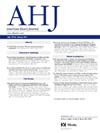左心耳关闭(ATLAAC)后抗凝治疗试验的原理和设计
IF 3.7
2区 医学
Q1 CARDIAC & CARDIOVASCULAR SYSTEMS
引用次数: 0
摘要
左心房附件闭合术(LAAC)已成为接受心脏手术的心房颤动患者口服抗凝治疗的推荐补充。该手术显著降低了中风和全身动脉栓塞的风险,考虑到相关的出血风险增加,口服抗凝剂(OAC)可能不必要甚至有害。该出版物描述了一项随机试验的基本原理和设计,验证了在主要终点方面,停止OAC并不亚于手术LAAC后继续OAC的假设。方法ATLAAC试验是一项多中心、随机、对照试验,旨在招募1220例接受手术LAAC并仍在OAC治疗的心房颤动患者。进行心脏CT扫描以确认LAAC的成功。成功闭合的患者随机停止或继续OAC。主要终点是首次发生缺血性卒中、全身性动脉栓塞或大出血,预计平均随访4年。次要终点包括全因死亡率、心血管死亡率、任何导致住院的出血、输血、静脉血栓栓塞、心肌梗死和生活质量指标。ATLAAC试验的报名于2024年3月开始。截至2025年1月18日,已有554名患者入组,319名患者被随机分组。预计征聘工作将持续约12个月。一旦出现128个主要终点,随访将停止。结论ATLAAC试验将评估LAAC术后停用OAC的安全性。试验注册号eu - ct: 2022-502986-92-00, clinicaltrials.gov ID: NCT06401616。本文章由计算机程序翻译,如有差异,请以英文原文为准。
Rationale and design of the anticoagulant therapy after left atrial appendage closure (ATLAAC) trial
Introduction
Left atrial appendage closure (LAAC) has become a recommended addition to oral anticoagulation for patients with atrial fibrillation, who undergo cardiac surgery. The procedure significantly reduces the risk of stroke and systemic arterial embolism, potentially making oral anticoagulation (OAC) unnecessary or even harmful, when considering the associated increased risk of bleeding. This publication describes the rationale and design of a randomized trial, testing the hypothesis that stopping OAC is noninferior to continuing OAC after surgical LAAC in terms of the primary endpoint.
Methods
The ATLAAC trial is a multicenter, randomized, controlled trial, aiming to enroll 1,220 patients with atrial fibrillation, who have undergone surgical LAAC and remain on OAC. A cardiac CT scan is performed to confirm success of the LAAC. Patients with successful closure are randomized to stop or continue OAC. The primary endpoint is the first occurrence of ischemic stroke, systemic arterial embolism, or major bleeding over an expected mean follow-up of 4 years. Secondary endpoints include all-cause mortality, cardiovascular mortality, any bleeding leading to hospitalization, blood transfusion, venous thromboembolism, myocardial infarction, and quality of life measures.
Trial status
Enrollment for the ATLAAC trial began in March 2024. As of January 18th, 2025, 554 patients have been enrolled in the study and 319 patients have been randomized. Recruitment is expected to continue for approximately 12 months. Follow-up will be stopped once 128 primary endpoints have occurred.
Conclusions
The ATLAAC trial will evaluate the safety of stopping OAC after surgical LAAC.
Trial registration number
EU-CT: 2022-502986-92-00, clinicaltrials.gov ID: NCT06401616.
求助全文
通过发布文献求助,成功后即可免费获取论文全文。
去求助
来源期刊

American heart journal
医学-心血管系统
CiteScore
8.20
自引率
2.10%
发文量
214
审稿时长
38 days
期刊介绍:
The American Heart Journal will consider for publication suitable articles on topics pertaining to the broad discipline of cardiovascular disease. Our goal is to provide the reader primary investigation, scholarly review, and opinion concerning the practice of cardiovascular medicine. We especially encourage submission of 3 types of reports that are not frequently seen in cardiovascular journals: negative clinical studies, reports on study designs, and studies involving the organization of medical care. The Journal does not accept individual case reports or original articles involving bench laboratory or animal research.
 求助内容:
求助内容: 应助结果提醒方式:
应助结果提醒方式:


